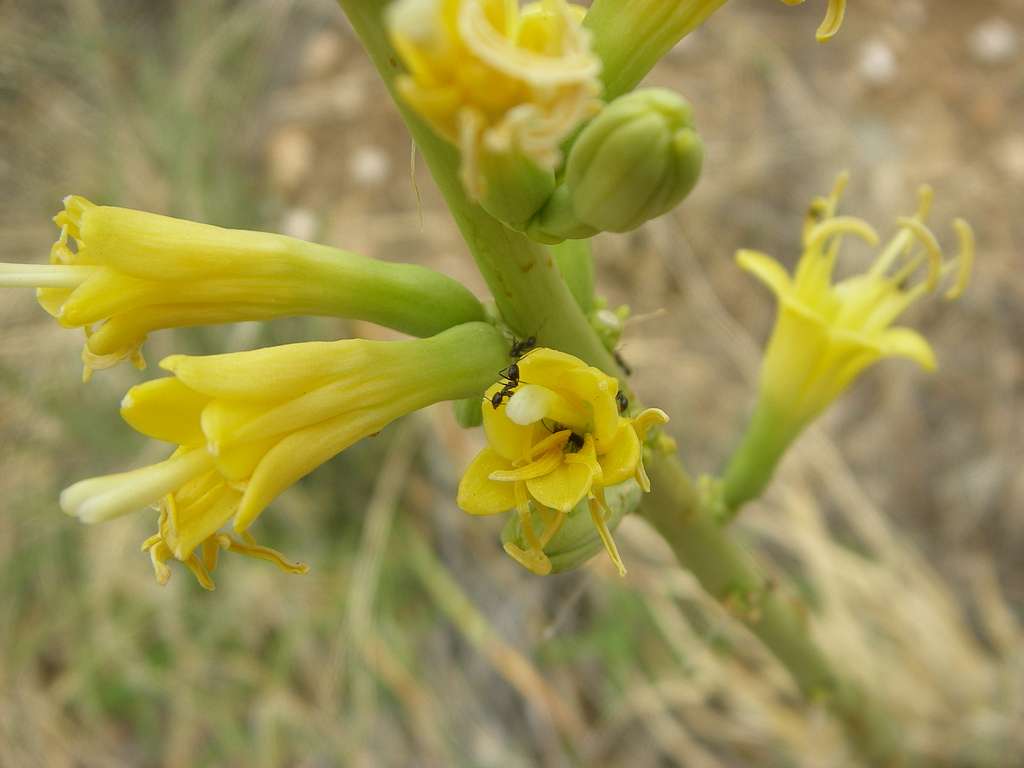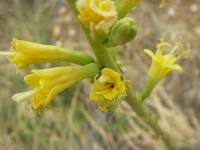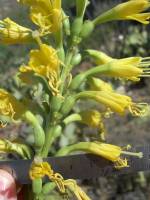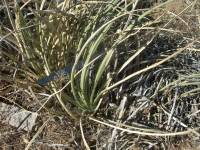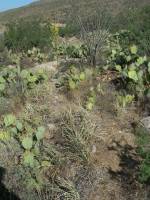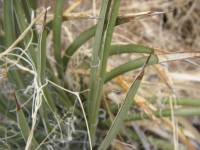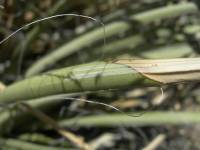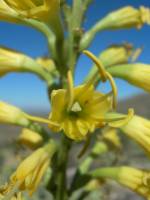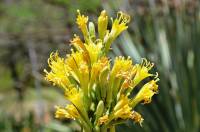Plants acaulescent, freely suckering; rosettes solitary or densely cespitose, 3-6 × 6-12 dm. Leaves mostly erect, widest near base, 20-40(-50) × 0.7-2.5 cm; blade yellowish green or deep green, with or without conspicuous white bud-prints on both surfaces, linear, firm, adaxially plane or somewhat concave toward apex, abaxially convex to deeply convex toward base; margins straight, filiferous or not, unarmed, fibers erect to spreading, sparse, white, filiform, brittle; apex acuminate to long-acuminate, spine brown or grayish, acicular, 0.8-1.9 cm. Scape 1.6-4 m. Inflorescences spicate or subspicate to narrowly racemose-paniculate, laxly flowered on distal 1/4-1/2; bracts caducous, narrowly triangular, 2-4 cm; peduncle 4 cm or shorter. Flowers 1 or 2-3(-6) per cluster, erect, (2.9-)3-5 cm; perianth yellow, tube funnelform, 8-11(-14) × 5-8(-13) mm, limb lobes erect to incurved, subequal, (7-)11-16 mm; stamens slightly exserted; filaments inserted high in perianth tube, 6-13 mm above tube base at 1 or 2 levels, erect, yellow, 1.5-2.2 cm; anthers light to deep yellow, (7.5-)10-17 mm; ovary 0.8-1.6 cm, neck constricted, 3-9 mm. Capsules short-pedicellate, obovoid, 1-2.2 cm, apex rounded to beaked. Seeds 3-3.5 mm.
Plant: perennial scapose herb; Rosettes densely caespitose, 30-60 cm high, 60-120 cm broad
Leaves: several to numerous, 20-40(-50) cm long, 6-25 mm wide, narrowly linear to linear, widest at the base, straight, incurved or falcate, pliant to rather stiff, flat or somewhat convex towards apex, convex to deeply convex towards base, yellowish green to deep green, the margins with a narrow brown and white border with or without, white brittle threadlike fibers; teeth absent; terminal spine 8-20 mm long, brown to gray, fine or stoutish, weak and brittle to somewhat firm, close-grooved for most of its length
INFLORESCENCE: with scape 1.3-2.5 m tall, spicate, subspicate, or narrowly racemose-paniculate, frequently crooked with numerous branchlets in upper 1/4 of flowering stalk, the stalk slender, green
Flowers: 30-50 mm long, single or usually in clusters of 2-3(-6), with a strong, sweet fragrance; tepals subequal, (7-)11-16 mm long, 4-6 mm wide, spreading unequally at anthesis, suberect to reflexed, bright yellow to deep yellow; filaments 15-22 mm long, inserted high in tube at 1 or 2 levels, the outer ones (5-)6-10 mm above base of tube, the inner ones 5-11 mm above base of tube, pale yellow to bright yellow, the anthers (7.5-)10-17 mm long, pale yellow to deep yellow; ovary 8-15 mm long with constricted curved neck 3-9 mm long, greenish-yellow to lime-green, the style 20-26 mm long when stigma is receptive, yellow; floral tube deeply funnelform, (8-)9-14 mm long, 5-8 mm wide, becoming very narrow towards base, lime-green to yellow
Fruit: capsules, 10-22 mm long, obovoid, rounded to apiculate; SEEDS 3-3.5 mm long
Misc: desert scrub, grassland, juniper and oak woodlands; May-Jul
REFERENCES: Hodgson, Wendy. 1999. Agavaceae. Ariz. - Nev. Acad. Sci. 32(1).
Common Name: Schott's century plant
Duration: Perennial
Nativity: Native
Lifeform: Succulent
General: Perennial scapose succulents, plants without stems except when flowering; rosettes in dense clusters, freely suckering, 30-60 cm tall and 60-120 cm across.
Leaves: Leaves widening at base, then tapering at tip, 1-2.5 cm wide, bluish-green, (occasionally yellowish-green) in color, often with bud prints evident on the blade; margins without teeth but sometimes producing threads, terminal spine 1-2 cm long.
Flowers: Scape 1.3 to 2.5 m tall; bracts not persistent, narrowly triangular; flowers arranged in a spike or sometimes in a narrow panicle, branches widely-spaced on distal 1/4-1/2 of the flowering stem; flowers 3-5 cm long, in clusters of 1-6; perianth funnelform, yellow in color; stamens exserted.
Fruits: Capsules on short pedicels, obovoid with a beaked or rounded apex, 1-2 cm long.
Ecology: Found in gravelly or rocky areas in desert scrub, grasslands, and juniper or oak woodlands, 3,000-6,500 ft (914-1981 m); flowers May-July.
Distribution: se AZ, sw NM; Sonora, MEX.
Notes: A. schottii is a small, narrow-leaved Agave with threads on the margins of the leaves and showy, yellow flowers. There are 2 varieties in the southwest. A. schottii var. schottii has narrower leaf blades 0.7-1.2 cm wide, and A. schottii var. treleasi has wider leaves 1.2-2.5 cm wide. Agave schottii and its varieties are thought to hybridize with A. chrysantha and each other, making positive identification more difficult.
Ethnobotany: Pit baked and used as food by the Papago tribe.
Etymology: Agave is from Greek agauos, admirable, noble; schottii honors Arthus Carl Victor Schott (1814-1875), a naturalist hired in 1851 by the United States Boundary Commission as a scientific collector.
Synonyms: None
Editor: LCrumbacher, 2011, AHazelton 2015


